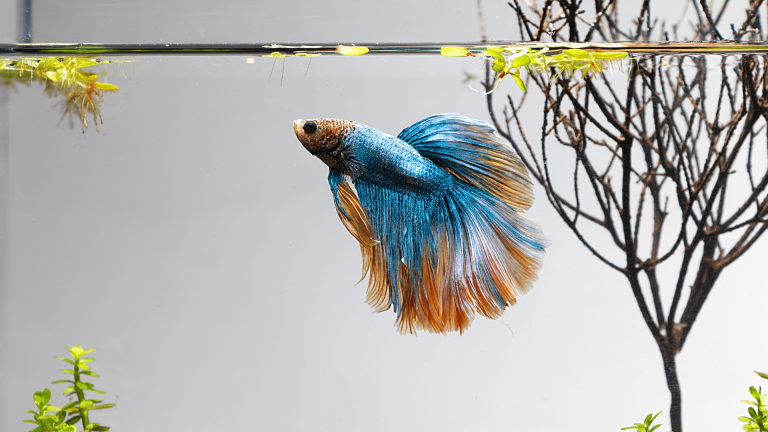10 Facts About Betta Fish
Contents
- 1 Hera are 10 Facts About Betta Fish
- 1.1 1. They Can Breathe Air (Facts About Betta Fish)
- 1.2 2. Betta Fish Originate from Thailand and Cambodia
- 1.3 3. Bettas Need Protein
- 1.4 4. Bettas Have an Unusual Courtship
- 1.5 5. Male Bettas Are More Colorful Than Females
- 1.6 6. Betta Fish Have Teeth
- 1.7 7. Betta Fish Can Regrow Damaged Fins
- 1.8 8. Easy to Differentiate Male and Female Betta Fish
- 1.9 9. Male Bettas Build Bubble Nests Before Breeding
- 1.10 10. Male Bettas Are Highly Territorial
- 2 Do Betta Fish Sleep?
- 3 Can You Touch Betta Fish, or Is It Harmful to Them?
- 4 Frequently Asked Questions (FAQs) About Facts About Betta Fish
- 4.1 What is Betta fish?
- 4.2 How big do Betta fish grow?
- 4.3 Why is Betta fish called Siamese fighting fish?
- 4.4 What colors do Betta fish come in?
- 4.5 How long do Betta fish live?
- 4.6 Do Betta fish need a filter?
- 4.7 Can Betta fish breathe air?
- 4.8 What water temperature is best for Betta fish?
- 4.9 Can Betta fish be kept in small bowls?
- 4.10 What do Betta fish eat?
- 4.11 Does Betta fish like plants in their tank?
- 4.12 Can Betta fish be housed with other fish?
- 4.13 How often should I clean the Betta fish tank?
- 4.14 Can Betta fish recognize their owners?
- 4.15 Do Betta fish require light in their tank?
- 4.16 Can Betta fish jump out of their tank?
- 4.17 How do Betta fish reproduce?
- 4.18 Are Betta fish easy to care for?
- 4.19 Can Betta fish be kept in unheated tanks?
- 4.20 Is Betta fish a good choice for beginners?
- 5 Conclusion
10 Facts About Betta Fish. Betta fish are some of the most well-known and stunning pet fish in the entire world, but it was only sometimes like this. More than 73 identified fish species belong to the genus Betta, but the Siamese fighting fish, Betta splendens, is the one with which most people are familiar. Wild betta fish are dull, greyish-green in color, and have small fins—unlike today’s stunning, long-finned beauties! Numerous fin forms and colors, such as veil, delta, half-moon, crown tail, and double tail, have been generated by selective breeding. We shall look at a few of the betta fish’s lesser-known characteristics in this article. Here are ten entertaining and fascinating tidbits about betta fish.
Hera are 10 Facts About Betta Fish
1. They Can Breathe Air (Facts About Betta Fish)

No, we’re not pulling on your fin; betta fish can breathe air much like people do, thanks to an organ called a labyrinth.
They can breathe air in and out of the water thanks to a unique organ that functions similarly to our lungs. Smart little fish!
2. Betta Fish Originate from Thailand and Cambodia
The betta fish, which originated in Southeast Asia, is now among the most well-liked fish in the entire world. However, its natural habitat is in the rice fields and floodplains of Thailand, Cambodia, Vietnam, and Laos.
The Mekong River and its tributaries are where you’ll mostly find these fish. As of February 2019, the betta fish formally acknowledge as a national aquatic animal. But given that it is designated as vulnerable in its environment by the conservation status, we might need to take care of it.
3. Bettas Need Protein

Bettas will eat practically everything you give them. However, they like to have protein as their primary food. Betta pellets can use as a pet’s primary food source, but your fish will also benefit from the odd serving of live or frozen brine shrimp and freeze-dried bloodworms. Feed your pet three pellets or less at a time every day. After five minutes, make careful to remove any food that is still in the tank. Due to their propensity for constipation, some hobbyists advise letting bettas fast once a week.
4. Bettas Have an Unusual Courtship

Bettas do not give birth to live young; instead, they lay eggs. The courtship between a man and a female before fertilization is fascinating. Since men and females will fight with each other when forced to share the same area, love initially appears more like a conflict.
When the male is allowed to see a female that sparks his fancy, he’ll build a nest at the water’s surface made of mucus-coated air bubbles. When the female introduces into his tank, he’ll flare up at her and chase her around a bit. She will also flare her gills and fins to hold him off. The male then shows his best side view to impress the female as he shimmies and spreads his fins. The female will hold very still as he approaches and rolls her over when she is ready to accept him. He will fertilize her eggs when she releases them since his body drapes over hers like a horseshoe.
5. Male Bettas Are More Colorful Than Females
Since they have more color and a wider variety of fin kinds, male betta fish have historically been more popular than female betta fish. Even though female bettas are more extensive, they lack the male Betta’s attractiveness.
Because of their small, “wild-type” fins, pet shops primarily stock male betta fish on their displays. Female betta fish typically have darker and more pronounced stripes than their male counterparts.
6. Betta Fish Have Teeth

Being carnivores, these little fish have a thin row of sharp teeth that they employ to grab insects and live prey. Although rarely seen and not strong enough to hurt a person, their teeth are nevertheless present.
They will also rip at the fins of competing bettas to defend their territory with their teeth. Additionally, bettas “chew” and pull at their food with their teeth to break it down and simplify swallowing.
7. Betta Fish Can Regrow Damaged Fins
A betta fish’s injured fins will begin to grow again after suffering a fin injury that results in fin loss or tearing. They might not appear as lovely as they did previously, though. Male betta fish, which come in a range of different fin types, are characterized by having lengthy fins.
They can easily harm their fins by snagging them on a decoration, tangling with another fish, succumbing to an illness like fin rot, or biting their tail.
Over the following few weeks, the injured areas will start to recover, and you’ll observe that the new growth will resemble a white piece of fin over the affected area.
8. Easy to Differentiate Male and Female Betta Fish
Generally speaking, it is simple to tell if a betta fish is male or female. You can distinguish between male and female fish based on a few variables that determine a fish’s gender. These criteria only apply to mature fish, making it far more challenging to do this with juvenile fish.
Compared to females, males have more vibrant colors, and females will have vertical stripes on their bodies. The females are often shorter and fatter than the males due to differences in their body forms. Additionally, males have longer fins and what appears to be a “beard” on the bottom of their skulls.
9. Male Bettas Build Bubble Nests Before Breeding
The betta fish breeding process is pretty fascinating. Here, the males are crucial because they construct nests before they begin reproducing. They accomplish this by swimming to the top, breathing, and blowing mucus-coated bubbles to form nests.
The male will then begin pursuing the female Betta. He then displays vibrant colors and flashes his fins to entice the female. The guy will start following the female if she doesn’t respond and will be relentless in his efforts.
10. Male Bettas Are Highly Territorial
You’ll note that bettas are typically shown in tiny containers when visiting an aquarium store. If you spot one in a communal tank, it’s probably the only specimen there. It’s because bettas are fiercely competitive with one another and will fight to the death to protect their area. Although they don’t seem as aggressive against other species, bettas occasionally nip their tank mates.
Do Betta Fish Sleep?

Most animals in the animal kingdom take sleeping for a few hours as a given. Cats and dogs can see napping. Even lizards and other reptiles seem to slumber occasionally.
What about Betta fish, though? It appears at first glance that these tenacious fish spend the entire day flaunting their exquisite fins.
But betta fish also snooze!
All fish require sleep, even if this fact is not widely known. It performs a crucial biological role. Your little Betta is conserving energy and slowing their metabolism at this time.
Underwater surroundings differ significantly from those on land—fish in the wild need to be vigilant if they wish to survive.
Even though your Betta is limited to the security of a decent tank, it still has the innate desire to be vigilant. The territorial character of Bettas makes this much more accurate.
Betta fish sleep very differently from mammals as a result. They are a thing of as “light sleepers.” The deep REM cycle that you experience does not apply to your fish. Instead, they take a little nap while constantly monitoring their environment.
Can You Touch Betta Fish, or Is It Harmful to Them?
Even though it could be alluring, petting your fish is not a good idea. Never allow human hands to contact a betta fish. It could result in various issues, including stress, illness, or the worst instance, mortality.

The best place to keep a betta is on the other side of the glass, away from your hands, so you can enjoy it visually.
We’ll examine some of the reasons why bettas shouldn’t ever handle, as well as some alternate exercises you can do to strengthen your bond with your Betta. A typical freshwater fish great for beginners is the betta fish, sometimes known as the Siamese fighting fish. Both male and female bettas offer for sale as aquatic pets, and they come in various colors and fin kinds.
These tropical fish are called “fighter fish” because of their striking beauty and hostile nature. In this post, we’ll review many fascinating facts about these lovely little fish, some of which may even surprise you.
Frequently Asked Questions (FAQs) About Facts About Betta Fish
What is Betta fish?
Betta fish, scientifically known as Betta splendens, are small freshwater fish native to Southeast Asia. They are known for their vibrant colors, long flowing fins, and territorial behavior.
How big do Betta fish grow?
Male Betta fish can grow to be around 2.5 to 3 inches (6.4 to 7.6 cm) in length, while females are slightly smaller, averaging about 2 inches (5.1 cm).
Why is Betta fish called Siamese fighting fish?
Betta fish earned the nickname “Siamese fighting fish” due to their aggressive nature. Male Betta fish are territorial and known to engage in combat with other males, displaying their long fins and vibrant colors.
What colors do Betta fish come in?
Betta fish come in various colors, including red, blue, green, yellow, orange, and purple. There are also variations with metallic or iridescent scales.
How long do Betta fish live?
On average, Betta fish live for about 2 to 4 years. However, a Betta fish can live up to 5 years or occasionally even longer with proper care.
Do Betta fish need a filter?
While a filter is not mandatory, providing a filter in the Betta fish tank is highly recommended. A filter helps maintain water quality by removing waste and promoting better oxygenation.
Can Betta fish breathe air?
Yes, Betta fish have a labyrinth organ that allows them to breathe air that contains oxygen. They can breathe through their gills and gulp air at the water’s surface.
What water temperature is best for Betta fish?
The ideal water temperature for betta fish is between 24°C and 28°C, or 75°F and 82°F. Maintaining a stable and suitable temperature for their overall health is essential.
Can Betta fish be kept in small bowls?
While Betta fish can survive in small bowls, it is not recommended for long-term well-being. They require a minimum tank size of 2.5 gallons (9.5 liters) to thrive and have ample swimming space.
What do Betta fish eat?
Betta fish are carnivorous and should be fed a balanced diet of high-quality betta pellets or flakes. They can also consume live or frozen foods such as brine shrimp, bloodworms, and daphnia.
Does Betta fish like plants in their tank?
Yes, Betta fish appreciate having live or artificial plants in their tank. The plants provide shelter and resting spots and help create a natural environment. Just ensure they have smooth leaves to prevent fin damage.
Can Betta fish be housed with other fish?
Male Betta fish are highly territorial and should be kept alone to avoid aggression. However, female Betta fish can sometimes coexist peacefully in groups called sororities, but careful monitoring is necessary.
How often should I clean the Betta fish tank?
Regular maintenance is essential to keep the Betta fish tank clean. It is recommended to perform a partial water change of 25-50% weekly and clean the tank and decorations monthly.
Can Betta fish recognize their owners?
While Betta fish don’t possess advanced cognition, they can become accustomed to their owner’s presence. They may show signs of recognition through behaviors like swimming toward them or flaring their fins.
Do Betta fish require light in their tank?
Betta fish need a regular light-dark cycle to maintain their biological rhythm. Providing 8-12 hours of light per day is recommended using a timer or natural daylight.
Can Betta fish jump out of their tank?
Yes, Betta fish are known for their jumping abilities. It is crucial to have a secure lid or cover on the tank to prevent them from escaping or injuring themselves.

How do Betta fish reproduce?
Betta fish are bubble nest breeders. During the breeding process, the male builds a nest of bubbles at the water’s surface. The female lays eggs, and the male fertilizes them and guards the nest until the fry hatch.
Are Betta fish easy to care for?
Betta fish can be relatively easy to care for but still require proper attention and maintenance. They thrive in a well-maintained tank with appropriate water conditions, regular feeding, and a suitable environment.
Can Betta fish be kept in unheated tanks?
While Betta fish can tolerate slightly cooler temperatures for short periods, keeping them in unheated tanks is not recommended. They require stable warm water to stay healthy and active.
Is Betta fish a good choice for beginners?
Betta fish are frequently suggested for beginners because of their hardiness and low maintenance needs. However, it’s important to research and provide proper care to ensure their well-being and longevity.
Conclusion
Betta fish are captivating creatures that continue to enchant aquarium enthusiasts with their beauty and intriguing behaviors. Understanding these 10 fascinating facts about Betta fish enhances our ability to provide them with the care and attention they deserve. Whether you’re a seasoned fish keeper or a beginner, Betta fish will bring joy and wonder to your aquatic hobby.







